Southern Kyoto and Uji
Fushimi Inari Shrine
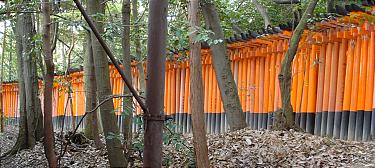
Fushimi Inari Shrine is the most famous of several thousands of shrines dedicated to Inari across Japan. Inari is the Shinto god of rice, and foxes are thought to be his messengers. Therefore, many fox statues can be found at Inari shrines.
Fushimi Inari Shrine is also famous for the countless torii gates, offerings by worshippers, that cover the hiking trails of Inarisan, the wooded mountain behind the shrine's main buildings. It takes about two hours to walk along the whole trail.
Kitsune Udon ("Fox Udon"), a noodle soup topped with pieces of aburaage (fried tofu), a favorite food of foxes, is served at small restaurants along the hiking trail.
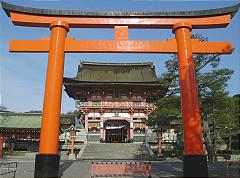 | 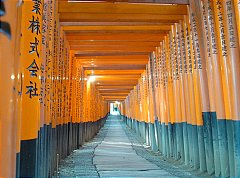 |
Fushimi Inari Shrine is located just outside JR Inari Station, the second station from Kyoto on the JR Nara Line. The train ride takes five minutes and costs 140 Yen from Kyoto Station.
Tofukuji
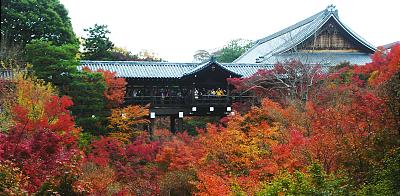
Tofukuji is a Zen temple, which was constructed in 1236 with the aim of building a temple in the style of Todaiji and Kofukuji, the two great temples of Nara. Note that the name "Tofukuji" is a combination of the names of the two model temples.
Each autumn, Tofukuji becomes one of Japan's most spectacular (and crowded) spots for autumn leaf viewing. The second half of November is usually the best time to view the ocean of colored trees in combination with the traditional temple architecture.
Tofukuji belongs to Kyoto's UNESCO world heritage sites.
Tofukuji is a 10-15 minute walk from Tofukuji Station on the Keihan Main Line and JR Nara Line. By JR, Tofukuji Station it is just one station from Kyoto Station (2 minutes, 140 Yen by local train).
Daigoji
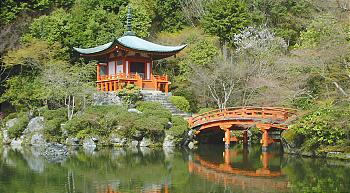
Daigoji is a temple complex in southeastern Kyoto, which has been designated an UNESCO world heritage site.
Sanboin is a large wooden building constructed in 1115 as the residence of Daigoji's archbishop. It includes a beautiful Japanese garden which was built for Toyotomi Hideyoshi's famous hanami (cherry blossom viewing) party of 1598.
In the Shimo-Daigo area of Daigoji stand most temple halls and structures including Kyoto's oldest building, a five storied pagoda dating from 951, and the Bentendo, a much photographed small temple hall to the goddess Benten.
If you want to see more, you can hike up to Kami-Daigo, the place where Daigoji was originally founded. The walk up takes about 45 minutes.
Daigoji is the last station on the Tozai Subway Line. From the station, it is a 15 minute walk to the temple.
From Kyoto Station, take the JR Tokaido, Kosei or Biwako Line to Yamashina Station, where you can transfer to the Tozai Subway Line.
Byodoin
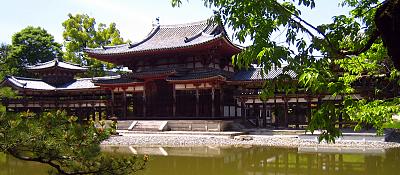
Byodoin features the most beautiful of Japan's few remaining Pure Land Gardens, a garden type which was popular during the Heian Period. The Phoenix Hall was built in 1053 by a member of the Fujiwara clan. It is one of Japan's most famous temple buildings and depicted on the 10 Yen coin.
On the temple grounds stands the Hoshokan which exhibits an assortment of the temple's treasures including dozens of designated important cultural properties and national treasures.
Byodoin is a 10-15 minute walk from JR Uji Station on the JR Nara Line. There are frequent local and rapid trains between Kyoto and Uji, taking between 15 and 25 minutes and costing 230 Yen for the one way trip.
Alternatively you can take the Keihan Uji Line from central Kyoto (Shijo Station) to Uji. The one way trip takes 30 minutes and costs 300 Yen. Byodoin is a 5 minute walk from Keihan Uji Station.
Mampukuji
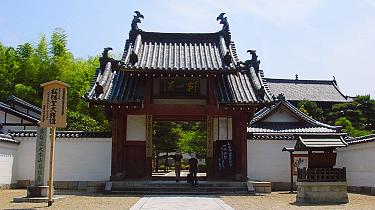
Mampukuji is the head temple of the Zen Obaku sect, which entered Japan from China through Nagasaki in 1654 as the last of Japan's three sects of Zen Buddhism (the other two are the Rinzai and Soto sects). Six years later, Mampukuji was built in an architecture style of China's Ming Dynasty.
Mampukuji is a 5 minute walk from JR Obaku Station on the JR Nara Line. There are two local trains per hours between Kyoto and Obaku Station, which take about 25 minutes and cost 230 Yen one way.
Alternatively you can take the Keihan Uji Line from central Kyoto (Shijo Station) to Keihan Obaku Station. The one way trip takes 30 minutes and costs 300 Yen, and Mampukuji is a 5-10 minute walk from the station.